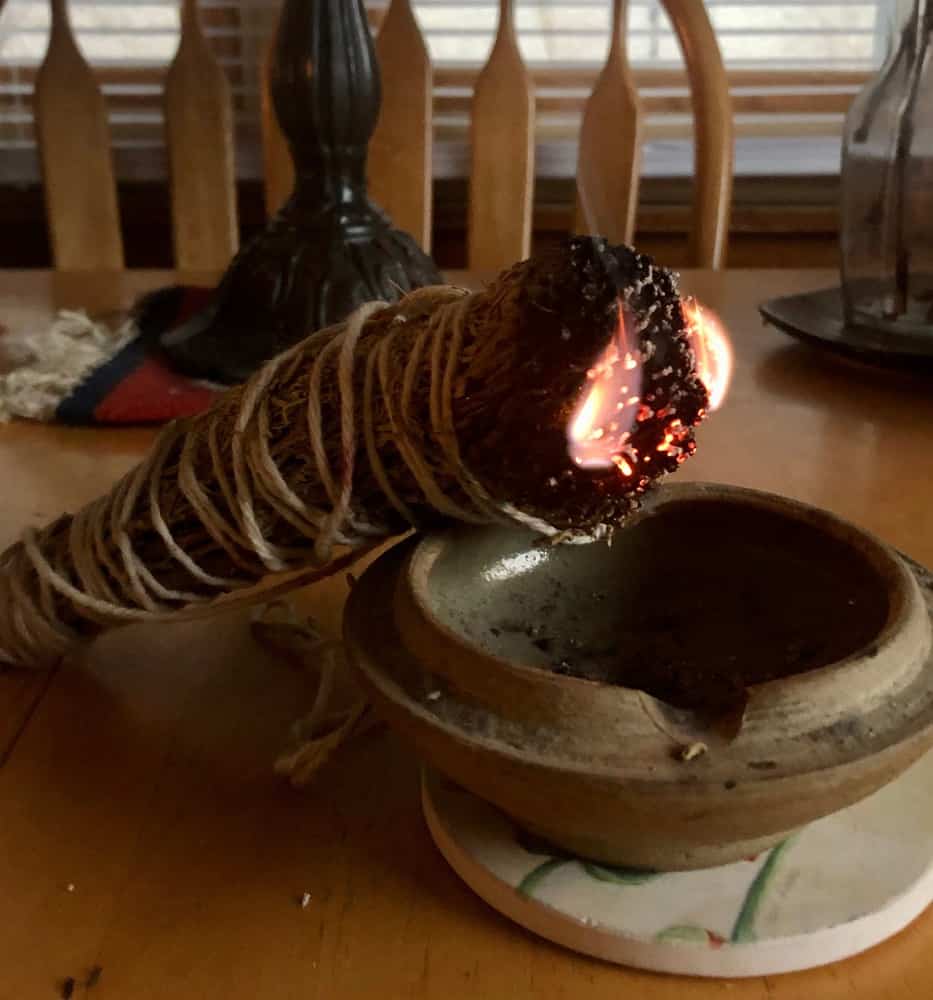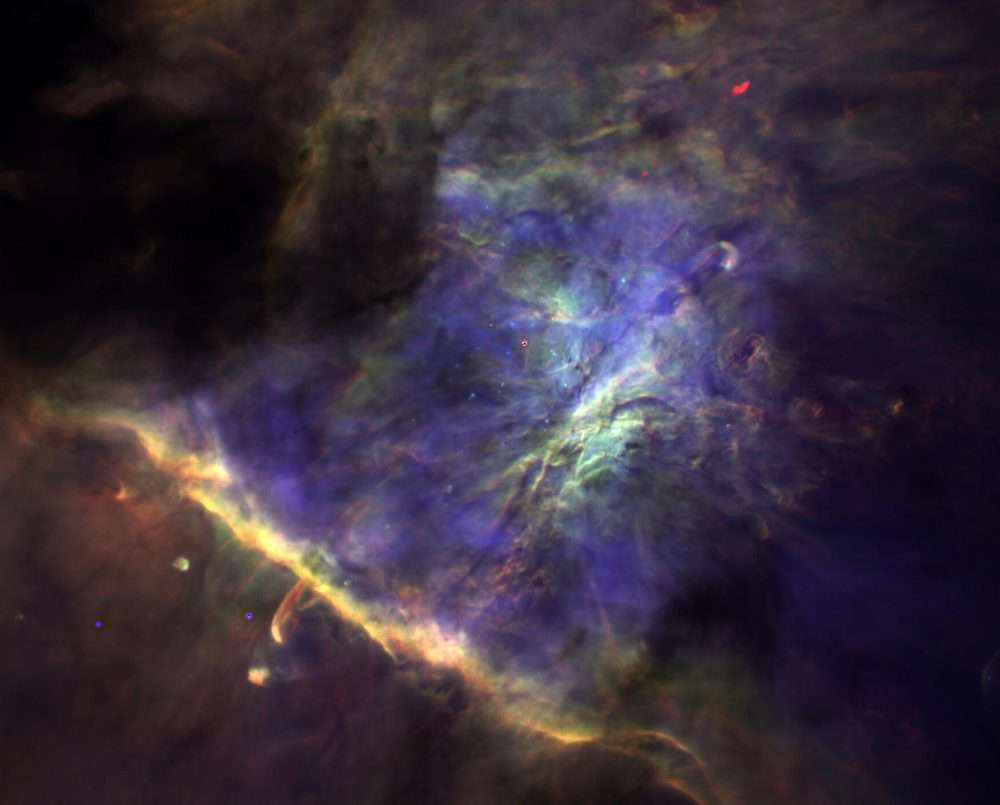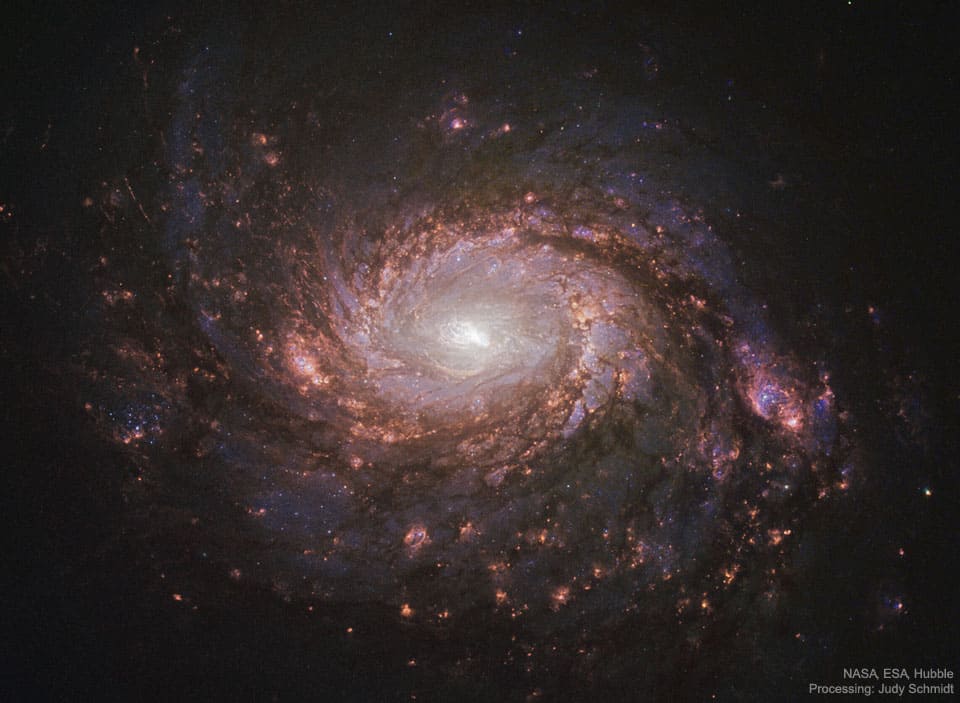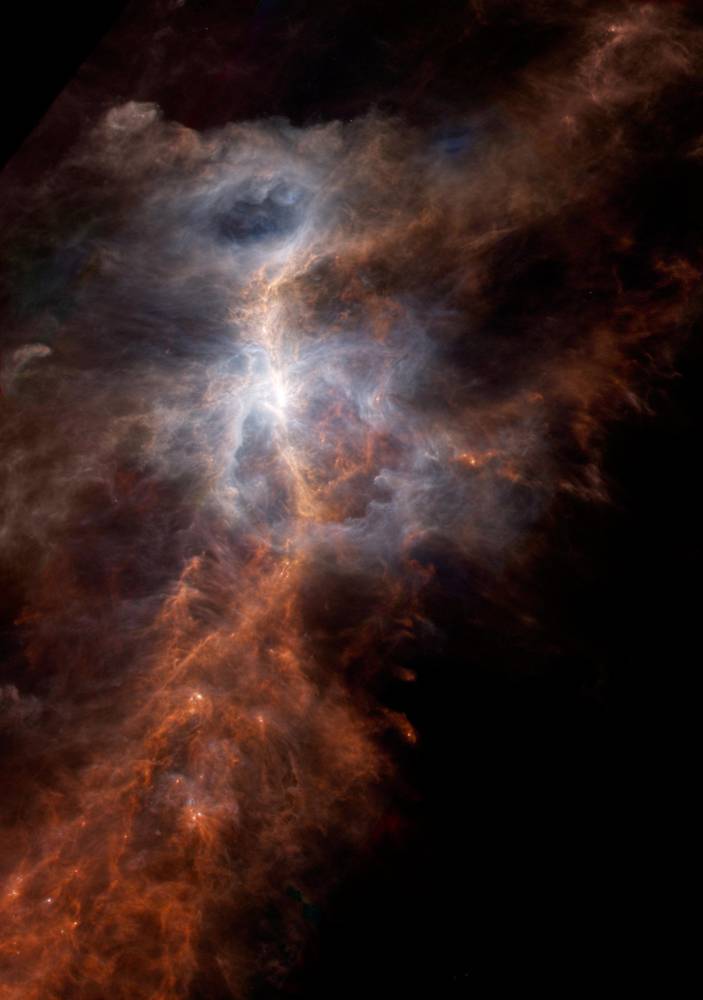Blog
Smudging my House with Sage brought from the Black Hills. Beliefs that burning sage clears out spiritual impurities, pathogens, and insects have been fundamental to the practice of smudging; it is also antimicrobial. We must purify our environments immediately! Call on every conceivable/viable process/force to eradicate this virus! And Pray, Meditate and Surround ourselves with Light! Together we are a IMPENETRABLE FORCE! We Will Survive!

more...
The Orion Bar stands out as a bright ridge to the Southeast of the Trapezium cluster, but its prominence is actually a consequence of limb brightening, i.e. our peculiar viewing angle. The Orion Nebula is bounded on multiple sides by an ionization front, but we happen to see the bar edge-on, causing it to appear brighter. Molecular hydrogen (H2) makes up 99% of the cold dense gas in galaxies. So mapping where stars are born basically means measuring H2, which lacks a strong characteristic signature at low temperatures. Astronomers from SRON Netherlands Institute for Space Research and the University of Groningen have now mapped an emission signal from the trace molecule hydrogen fluoride (HF), in a place where the standard trace molecule carbon monoxide is absent. They are the first to produce a map of HF for a region in space, creating a new tool to indirectly map H2. Publication in Astronomy & Astrophysics on November 6th.
he Orion Nebula (also known as Messier 42, M42, or NGC 1976) is a diffuse nebula situated in the Milky Way, being south of Orion’s Belt in the constellation of Orion. It is one of the brightest nebulae, and is visible to the naked eye in the night sky. M42 is located at a distance of 1,344 ± 20 light years and is the closest region of massive star formation to Earth. The M42 nebula is estimated to be 24 light years across. It has a mass of about 2,000 times that of the Sun. Older texts frequently refer to the Orion Nebula as the Great Nebula in Orion or the Great Orion Nebula.

Andy Narell (born March 18, 1954) is a jazz steel pannist.
Narell took up the steelpan at a young age in Queens, New York. His father, who was a social worker, had started a program of steelpan playing for at-risk youth at the Jewish philanthropic Education Alliance in Lower East Side Manhattan using two sets of pans made by Rupert Sterling, a native of Antigua. Beginning in 1962, Andy, his brother Jeff, and three others boys played on a third set of Sterling-made pans in the basement of the Narell house in the Whitestone neighborhood of Queens, calling themselves the Steel Bandits. The band was a novelty steelpan act that played concerts and appeared on television shows, including I’ve Got a Secret in 1963.
The band played Carnegie Hall and at the National Music Festival of Trinidad. Murray Narell invited Ellie Mannette in 1964 to expand steelpan activities in New York City and convinced him to come in 1967. Mannette taught the Narell boys more technique, and they played on improved pans tuned by Mannette.
Narell studied music at the University of California, Berkeley and played piano with the University of California Jazz Ensembles under the direction of David W. Tucker. He graduated in 1973.
more...William Richard Frisell (born March 18, 1951) is an American guitarist, composer and arranger.[1] One of the leading guitarists in jazz since the late 1980s, Frisell came to prominence as a stalwart for ECM Records. He went on to work in a variety of contexts, notably as a member of the New York City Downtown Scene where he formed a long partnership with John Zorn. He was also a longtime member of Paul Motian‘s groups from the early 1980s until Motian’s death in 2011. Since 2000, Frisell’s eclectic output as a bandleader has emphasized folk, country music, and Americana.
Frisell was born in Baltimore, Maryland, United States, but spent most of his youth in the Denver, Colorado, area.[1] He studied clarinet with Richard Joiner of the Denver Symphony Orchestra as a youth, graduated from Denver East High School, and went to the University of Northern Colorado to study music.
His original guitar teacher in the Denver-Aurora metropolitan area was Dale Bruning, with whom Frisell released the 2000 duo album Reunion. After graduating from Northern Colorado, where he studied with Johnny Smith, Frisell went to the Berklee College of Music in Boston, where he studied with Jon Damian and Jim Hall.
more...Lester J. Kinsey Jr., (March 18, 1927 – April 3, 2001) known as Big Daddy Kinsey, was an American Chicago blues singer, guitarist and harmonica player.
He was born near Pleasant Grove, Mississippi. He grew up playing gospel music; his father was a pastor in the Church of God in Christ and disapproved of blues music. However, Kinsey started playing guitar at parties in Mississippi, before moving in 1944 to Gary, Indiana, where he worked in a steel mill. He married and served in the military before returning to work in Gary and raising a family.
In the late 1950s, he started a family band, Big Daddy Kinsey and His Fabulous Sons, with his children, but it dissolved in the early 1970s, and Lester Kinsey began playing harmonica with a local band, the Soul Brothers. His second son, guitarist Donald Kinsey, played in Albert King‘s band in the 1970s, and later joined Bob Marley and the Wailers, but in 1984 rejoined his father and brothers Ralph and Kenneth to form The Kinsey Report. The band featured Lester “Big Daddy” Kinsey as slide guitarist and harmonica player. They signed for the Rooster Blues label, and in 1985 with Alligator Records, becoming “one of the hottest attractions in contemporary blues”. In the early 1990s Kinsey recorded the album I Am the Blues, featuring such musicians as Buddy Guy, James Cotton, and Pinetop Perkins.
As well as leading his band, Lester Kinsey also established a bus company running charter trips to casinos in the southern States. He developed prostate cancer, and died in Gary in 2001 aged 74. His sons have continued to perform as The Kinsey Report.
more...Wilson Pickett (March 18, 1941 – January 19, 2006) was an American singer and songwriter.
A major figure in the development of American soul music, Pickett recorded over 50 songs which made the US R&B charts, many of which crossed over to the Billboard Hot 100. Among his best-known hits are “In the Midnight Hour” (which he co-wrote), “Land of 1,000 Dances“, “Mustang Sally“, and “Funky Broadway“.
Pickett was inducted into the Rock and Roll Hall of Fame in 1991, in recognition of his impact on songwriting and recording.
Pickett was born March 18, 1941 in Prattville, Alabama, and sang in Baptist church choirs. He was the fourth of 11 children and called his mother “the baddest woman in my book,” telling historian Gerri Hirshey: “I get scared of her now. She used to hit me with anything, skillets, stove wood — (one time I ran away) and cried for a week. Stayed in the woods, me and my little dog.” Pickett eventually left to live with his father in Detroit in 1955.
Pickett’s forceful, passionate style of singing was developed in the church and on the streets of Detroit, under the influence of recording stars such as Little Richard, whom he referred to as “the architect of rock and roll.”
more...Lets try to find some peace on this very worrisome St Patricks Day during the World Pandemic invading our planet.
Turlough O’Carolan was a blind Celtic Harper of the 18th c.
Love each other now more than ever! And Be so very careful every moment and protect your loved ones!
God Bless You All
War on Coronavirus!
more...The face-on galaxy lies a mere 47 million light-years away toward the constellation of the Sea Monster (Cetus). At that estimated distance, this gorgeous island universe is about 100 thousand light-years across. Also known as NGC 1068, its compact and very bright core is well studied by astronomers exploring the mysteries of supermassive black holes in active Seyfert galaxies. M77 and its active core glows bright at x-ray, ultraviolet, visible, infrared, and radio wavelengths. The featured sharp image of M77 was taken by the Hubble Space Telescope and is dominated by the (visible) red light emitted by hydrogen. The image shows details of the spiral’s winding spiral arms as traced by obscuring dust clouds, and red-tinted star forming regions close in to the galaxy’s luminous core.

Paul Lorin Kantner (March 17, 1941 – January 28, 2016) was an American rock musician. He is best known as the co-founder, rhythm guitarist, and occasional vocalist of Jefferson Airplane, a leading psychedelic rock band of the counterculture era. He continued these roles as a member of Jefferson Starship, Jefferson Airplane’s successor band.
Jefferson Airplane formed in 1965 when Kantner met Marty Balin. Kantner eventually became the leader of the group and led it through its highly successful late-1960s period. In 1970, while still active with Jefferson Airplane, Kantner and several Bay Area musicians recorded a one-off side project, Blows Against the Empire under the name “Paul Kantner/Jefferson Starship”.
Jefferson Airplane continued to record and perform until 1973. Kantner revived the Jefferson Starship name in 1974 and continued to record and perform with them through 1984. He later led a reformed Jefferson Starship from 1992 until his death in 2016. Kantner had the longest continuous membership with the band, with 19 years in the original run of Jefferson Airplane and Jefferson Starship and 24 years in the revived Jefferson Starship. At times, he was the only founding Jefferson Airplane member to remain in Jefferson Starship. He was inducted into the Rock and Roll Hall of Fame as a member of Jefferson Airplane in 1996.
Kantner was born on March 17, 1941, in San Francisco, California, the son of Cora Lee (Fortier) and Paul Schell Kantner. Kantner had a half-brother and a half-sister by his father’s first marriage, both much older than he. His father was of German descent, and his mother was of French and German ancestry. His mother died when he was eight years old, and Kantner remembered that he was not allowed to attend her funeral; his father sent him to the circus instead.
After his mother’s death, his father, who was a traveling salesman, sent young Kantner to Catholic military boarding school. At the age of eight or nine, in the school’s library, he read his first science fiction book, finding an escape by immersing himself in science fiction and music from then on. As a teenager he went into total revolt against all forms of authority, and he decided to become a protest folk singer in the manner of his musical hero, Pete Seeger.
more...Paul Horn (March 17, 1930 – June 29, 2014) was an American flautist, saxophonist, composer and producer. He became a pioneer of world and new age music with his 1969 album, Inside.
Horn was born on March 17, 1930 in New York City and has Jewish roots through his father. The family moved to Washington, D.C. when Horn was four. He took up the piano at age four, followed by the clarinet at 12. While in Washington, D.C., Horn attended Theodore Roosevelt High Schooland the Washington College of Music. In the summer of 1942, Horn worked as an usher at the Earl Theatre to buy a clarinet. He studied the clarinet and flute at the Oberlin Conservatory of Music in Ohio, earning a bachelor’s degree. In June 1953, Horn gained a master’s from the Manhattan School of Music.
Moving to Los Angeles he played with Chico Hamilton‘s quintet from 1956 to 1958 and became an established West Coast session player. He played on the Duke Ellington Orchestra’s Suite Thursday and worked with Nat King Cole, Tony Bennett and others. He scored the 1959 animated television series Clutch Cargo.
In 1960 Horn recorded for Fantasy Records with Latin Jazz vibraphonist Cal Tjader (with drummers Willie Bobo and Mongo Santamaria) for the album Latino! (originally released in 1962 and later re-released with the same title in 1992.)
more...Lovie Lee (March 17, 1909 – May 23, 1997) was an American electric blues pianist and singer. He is best known for his work accompanying Muddy Waters. He also recorded a solo album, in 1992. He was the “adoptive stepfather” of the bluesman Carey Bell and thus the “grandfather” of Lurrie Bell.
He was born Edward Lee Watson in Chattanooga, Tennessee, and grew up in Meridian, Mississippi. He taught himself to play the piano and began performing in various churches and at rodeos and vaudeville shows. He had already acquired the nickname Lovie from a doting aunt. He found part-time employment playing with the Swinging Cats in the early 1950s. The group included Carey Bell, who Lee took under his “fatherly” protection, and together they moved to Chicago, in September 1956.[ Lee worked during the day in a woodworking factory, and for many years played in the evening in numerous Chicago blues nightclubs, including Porter’s Lounge. He was well known around Chicago for his blues piano playing.He later worked as an upholsterer, but he kept together his backing band, the Sensationals.
After he retired from full-time day work, Lee joined Muddy Waters‘s band in 1979, replacing Pinetop Perkins on the piano. He was recommended to Muddy Waters by George “Mojo” Buford, who had worked with Lee in North Dakota. Lee stayed with the band until Muddy Waters’s death, in 1983, and then returned to playing in Chicago clubs.
Lee made some private recordings in 1984 and 1989, and this work plus later contemporary tracks were released as the album Good Candy (1992). His backing musicians for the album included Eddie Taylor, Odie Payne, Carey Bell and Lurrie Bell.
more...Nathaniel Adams Coles (March 17, 1919 – February 15, 1965), known professionally as Nat King Cole, was an American singer and jazz pianist. He recorded over one hundred songs that became hits on the pop charts. His trio was the model for small jazz ensembles that followed. Cole also acted in films and on television and performed on Broadway. He was the first African-American man to host an American television series. He is the father of singer/songwriter Natalie Cole.
Nathaniel Adams Coles was born in Montgomery, Alabama, on March 17, 1919. He had three brothers: Eddie (1910–1970), Ike (1927–2001), and Freddy (b. 1931), and a half-sister, Joyce Coles. Each of the Cole brothers pursued careers in music. When Nat King Cole was four years old, the family moved to Chicago, Illinois, where his father, Edward Coles, became a Baptist minister.
When he was fifteen, Cole dropped out of high school to pursue a music career. After his brother Eddie, a bassist, came home from touring with Noble Sissle, they formed a sextet and recorded two singles for Decca in 1936 as Eddie Cole’s Swingsters. They performed in a revival of the musical Shuffle Along. Nat Cole went on tour with the musical. In 1937, he married Nadine Robinson, who was a member of the cast. After the show ended in Los Angeles, Cole and Nadine settled there while he looked for work. He led a big band, then found work playing piano in nightclubs. When a club owner asked him to form a band, he hired bassist Wesley Prince and guitarist Oscar Moore. They called themselves the King Cole Swingsters after the nursery rhyme in which “Old King Cole was a merry old soul.” They changed their name to the King Cole Trio before making radio transcriptions and recording for small labels.
Cole recorded “Sweet Lorraine” in 1940, and it became his first hit. According to legend, his career as a vocalist started when a drunken bar patron demanded that he sing the song. Cole said that this fabricated story sounded good, so he didn’t argue with it. In fact there was a customer one night who demanded that he sing, but because it was a song Cole didn’t know, he sang “Sweet Lorraine” instead. As people heard Cole’s vocal talent, they requested more vocal songs, and he obliged.
In 1941 the trio recorded “That Ain’t Right” for Decca, followed the next year by “All for You” for Excelsior. They also recorded “I’m Lost“, a song written by Otis René, the owner of Excelsior.
Cole appeared in the first Jazz at the Philharmonic concerts in 1944. He was credited on Mercury as “Shorty Nadine”, a derivative of his wife’s name, because he had an exclusive contract with Capitol since signing with the label the year before. He recorded with Illinois Jacquet and Lester Young.
In 1946 the trio broadcast King Cole Trio Time, a fifteen-minute radio program. This was the first radio program to be sponsored by a black musician. Between 1946 and 1948 the trio recorded radio transcriptions for Capitol Records Transcription Service.[23][24] They also performed on the radio programs Swing Soiree, Old Gold, The Chesterfield Supper Club, Kraft Music Hall, and The Orson Welles Almanac.
Cole began recording and performing pop-oriented material in which he was often accompanied by a string orchestra. His stature as a popular star was cemented by hits such as “All for You” (1943), “The Christmas Song” (1947), “(Get Your Kicks on) Route 66“, “(I Love You) For Sentimental Reasons” (1946), “There! I’ve Said It Again” (1947), “Nature Boy” (1948), “Frosty The Snowman“, “Mona Lisa” (No. 1 song of 1950), “Orange Colored Sky” (1950), “Too Young” (No. 1 song of 1951).
more...
Our last get together day of striking the set of Urinetown at Illusion Theater by Theater 55. Sunday March 15h 2020.
more...This infrared image of the Orion nebula allows astronomers to see dust that’s aglow from star formation. The central light-blue region is the hottest part of the nebula, and as the byproducts of the star factory are ejected out, they cool off and appear red. The Orion Nebula (also known as Messier 42, M42, or NGC 1976) is a diffuse nebula situated in the Milky Way, being south of Orion’s Belt in the constellation of Orion. It is one of the brightest nebulae, and is visible to the naked eye in the night sky. M42 is located at a distance of 1,344 ± 20 light years and is the closest region of massive star formation to Earth. The M42 nebula is estimated to be 24 light years across. It has a mass of about 2,000 times that of the Sun. Older texts frequently refer to the Orion Nebula as the Great Nebula in Orion or the Great Orion Nebula.

Jerry Jeff Walker (born Ronald Clyde Crosby; March 16, 1942, Oneonta, New York, United States) is an American country music singer and songwriter. He is best known for writing “Mr. Bojangles“.
Walker’s maternal grandparents played for square dances in the Oneonta area, with his grandmother, Jessie Conroe, playing piano, and grandfather playing fiddle. During the late 1950s, Crosby was a member of a local Oneonta teen band called The Tones.
The band traveled to Philadelphia to audition for Dick Clark‘s American Bandstand, but were turned down. Members of the band found Dick Clark’s house and were able to get a recommendation to audition at New York City‘s Baton Records through the company’s lead producer Sol Rabinowitz. The band was given a recording contract, but the studio wanted a quintet backed by studio musicians, which left Crosby and another member (Gerald T. Russell) out of their recordings.
After high school, Crosby joined the National Guard, but his thirst for adventure led him to go AWOL and roam the country busking for a living in New Orleans and throughout Texas, Florida, and New York, often accompanied by H.R. Stoneback (a friendship referenced in 1970’s “Stoney”). He played mostly ukulele until Harriet Ottenheimer, one of the founders of The Quorum, got him settled on a guitar in 1963. He adopted his stage name “Jerry Jeff Walker” in 1966.
more...More Posts
- Townes Van Zandt
- Louis Cottrell Jr
- Alcide Louis “Slow Drag” Pavageau
- Maurice Ravel
- SUPPORT UKRAINE World Music from Ukraine with Doox
- Daily Roots with Don Carlos
- The Dragon Who Like Spit Fire-FINAL PERFORMANCE
- Cosmos Venus Eclipse
- David Gilmour
- Flora Purim
- Wes Montgomery
- Howard McGhee
- Bob Wills
- SUPPORT UKRAINE World Music with Ukrainian electro-folk group Folknery
- Daily Roots with Playing for Change
- The Dragon Who Liked To Spit Fire
- Cosmos NGC 4565
- Eddy Grant
- J. B. Lenoir
- Lou Levy